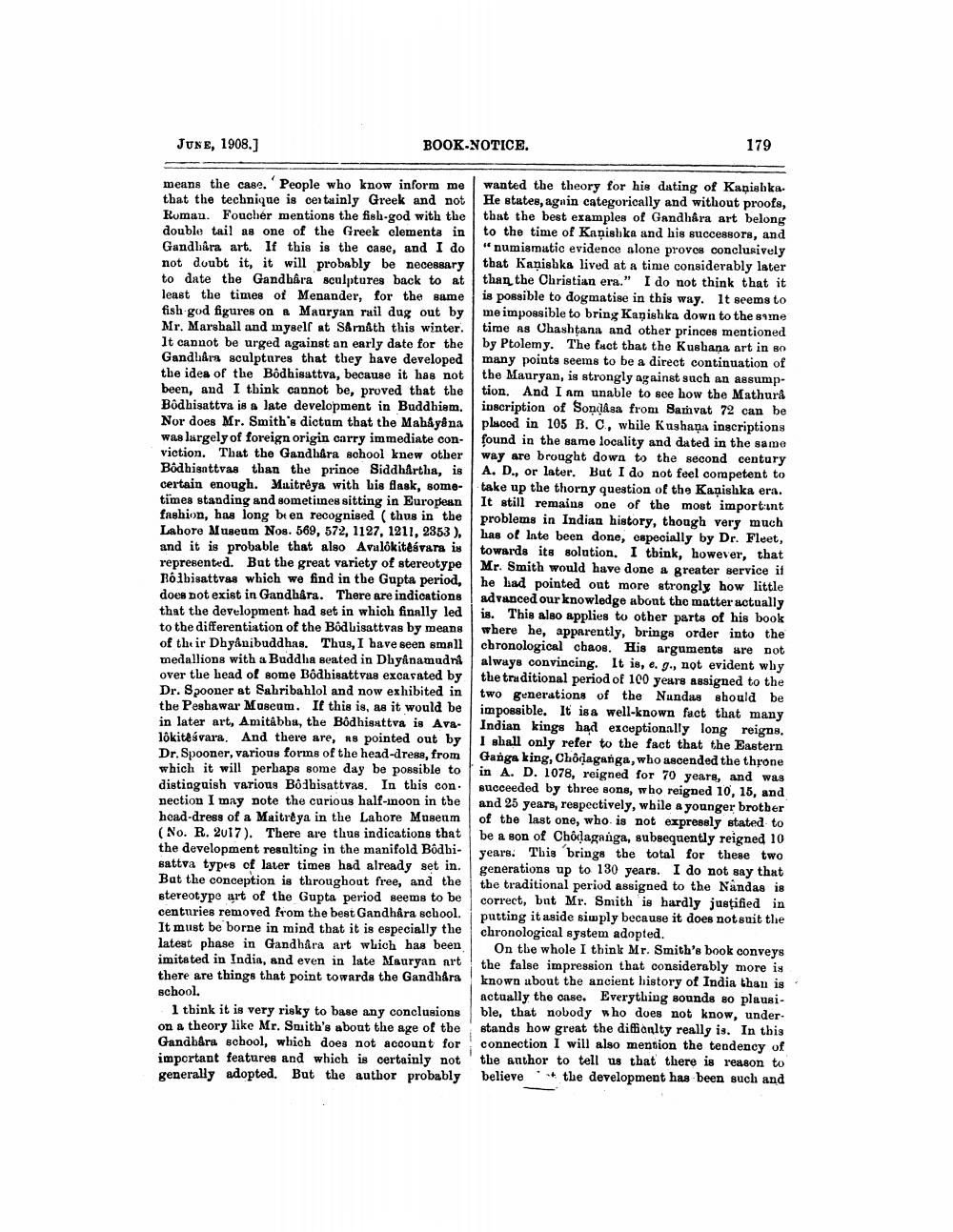________________
JUNE, 1908.]
means the case. People who know inform me that the technique is certainly Greek and not Roman. Fouchér mentions the fish-god with the double tail as one of the Greek elementa in Gandhara art. If this is the case, and I do not doubt it, it will probably be necessary to date the Gandhara sculptures back to at least the times of Menander, for the same fish god figures on a Mauryan rail dug out by Mr. Marshall and myself at Sarnath this winter. It cannot be urged against an early date for the Gandhara sculptures that they have developed the idea of the Bodhisattva, because it has not been, and I think cannot be, proved that the Bodhisattva is a late development in Buddhism. Nor does Mr. Smith's dictum that the Mahâyâna was largely of foreign origin carry immediate conviction. That the Gandhara school knew other Bodhisattvas than the prince Siddhartha, is certain enough. Maitreya with his flask, sometimes standing and sometimes sitting in European fashion, has long been recognised (thus in the Labore Museum Nos. 569, 572, 1127, 1211, 2353), and it is probable that also Avalokitesvara is represented. But the great variety of stereotype Rolbisattvas which we find in the Gupta period, does not exist in Gandhåra. There are indications that the development. had set in which finally led to the differentiation of the Bodhisattvas by means of the ir Dhyanibuddhas. Thus, I have seen small medallions with a Buddha seated in Dhyanamudra over the head of some Bodhisattvas excavated by Dr. Spooner at Sahribahlol and now exhibited in the Peshawar Museum. If this is, as it would be in later art, Amitabha, the Bodhisattva is Avalokitesvara. And there are, as pointed out by Dr. Spooner, various forms of the head-dress, from which it will perhaps some day be possible to distinguish various Bodhisattvas. In this con nection I may note the curious half-moon in the head-dress of a Maitreya in the Lahore Museum (No. R. 2017). There are thus indications that the development resulting in the manifold Bôdhisattva types of later times had already set in.. But the conception is throughout free, and the stereotype art of the Gupta period seems to be centuries removed from the best Gandhåra school. It must be borne in mind that it is especially the latest phase in Gandhara art which has been imitated in India, and even in late Mauryan art there are things that point towards the Gandhåra school.
BOOK-NOTICE.
1 think it is very risky to base any conclusions on a theory like Mr. Smith's about the age of the Gandhara school, which does not account for important features and which is certainly not generally adopted. But the author probably
179
wanted the theory for his dating of Kanishka. He states, again categorically and without proofs, that the best examples of Gandhåra art belong to the time of Kanishka and his successors, and "numismatic evidence alone proves conclusively that Kanishka lived at a time considerably later than the Christian era." I do not think that it is possible to dogmatise in this way. It seems to me impossible to bring Kanishka down to the same time as Chashtana and other princes mentioned by Ptolemy. The fact that the Kushana art in so many points seems to be a direct continuation of the Mauryan, is strongly against such an assumption. And I am unable to see how the Mathurå inscription of Sondasa from Bamvat 72 can be placed in 105 B. C, while Kushana inscriptions found in the same locality and dated in the same way are brought down to the second century A. D., or later. But I do not feel competent to take up the thorny question of the Kanishka era. It still remains one of the most important problems in Indian history, though very much has of late been done, especially by Dr. Fleet, towards its solution. I think, however, that Mr. Smith would have done a greater service if he had pointed out more strongly how little advanced our knowledge about the matter actually is. This also applies to other parts of his book where he, apparently, brings order into the chronological chaos. His arguments are not always convincing. It is, e. g., not evident why the traditional period of 100 years assigned to the two generations of the Nandas should be impossible. It is a well-known fact that many Indian kings had exceptionally long reigns. I shall only refer to the fact that the Eastern Ganga king, Chôdaganga, who ascended the throne in A. D. 1078, reigned for 70 years, and was succeeded by three sons, who reigned 10, 15, and and 25 years, respectively, while a younger brother of the last one, who is not expressly stated to be a son of Chôdaganga, subsequently reigned 10 years. This brings the total for these two generations up to 130 years. I do not say that the traditional period assigned to the Nandas is correct, but Mr. Smith is hardly justified in putting it aside simply because it does not suit the chronological system adopted.
On the whole I think Mr. Smith's book conveys the false impression that considerably more is known about the ancient history of India than is actually the case. Everything sounds so plausible, that nobody who does not know, understands how great the difficulty really is. In this connection I will also mention the tendency of the author to tell us that there is reason to believe the development has been such and




